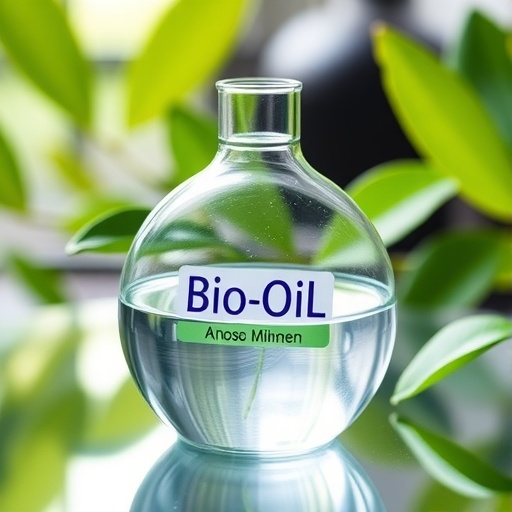In a groundbreaking study published in Waste Biomass Valor, researchers led by Dias, I.A. delve into the burgeoning scope of biorefineries powered by bio-oil. The study underscores the aqueous phase of bio-oil, often overlooked, and explores its potential to yield high-value-added products. This exploration is timely, given the contemporary urgency to shift away from fossil fuels and move towards renewable resources. Bio-oil obtained from biomass through pyrolysis has emerged as an essential player in this transition, primarily due to its rich composition of organic compounds that can be further processed.
The aqueous phase of bio-oil is particularly rich in water-soluble organic compounds, making it a treasure trove of resources that can be extracted and converted into commercially viable products. This phase, which constitutes a significant portion of the bio-oil, is often considered a residual waste in many processing scenarios. However, the study posits that utilizing this aqueous phase could unlock numerous opportunities for innovation in the biorefinery sector. The researchers advocate for a paradigm shift in the perception of bio-oil components, particularly emphasizing the economic viability of the aqueous phase.
One of the critical aspects of the research is the identification of strategies needed to recover high-value-added products from the aqueous phase. This includes the extraction of phenolic compounds, acids, and other bioactive materials, which have applications across various industries, including pharmaceuticals, cosmetics, and food. By recovering these compounds, biorefineries can increase their product portfolio and revenue streams, making the bio-refinery platform much more attractive to investors and stakeholders in the field.
The paper details the methodologies that can be employed to efficiently harvest these valuable materials from the aqueous phase. Advanced techniques such as liquid-liquid extraction, membrane filtration, and adsorption processes are discussed extensively. Each method presents unique advantages and potential limitations, requiring careful consideration based on the specific target compounds and the desired purity levels. Moreover, the integration of these methodologies into existing biorefinery operations is explored, providing a feasible roadmap for implementation.
Another focus of the study is the economic implications of utilizing the aqueous phase in biorefineries. By adding value to what was once seen as waste, biorefineries can enhance their profitability and sustainability. The authors present a thorough economic analysis that highlights how different recovery strategies can significantly impact the overall economic feasibility of biorefineries. This analysis makes a compelling case for adopting these recovery techniques for stakeholders who may be apprehensive about the initial investment costs associated with new processes.
The environmental benefits of extracting high-value products from the aqueous phase cannot be overstated. The harmful practice of disposing of the aqueous fraction of bio-oil not only leads to waste but also contributes to environmental degradation. By reintroducing these materials back into the economy, the research offers an eco-friendly solution to biomass utilization. These practices align with global sustainability goals, presenting an environmentally responsible way to transition towards a bio-based economy.
The possibility of producing innovative materials from the aqueous phase also opens up new avenues for research and development. The demand for sustainable alternatives in various sectors is continually growing, enhancing the urgency for breakthroughs in the field of biorefinery science. The findings from this study inspire further exploratory research, especially into the chemical transformations that can be applied to the compounds extracted from the aqueous phase. The future of materials science may hinge significantly on advancements in this area.
Furthermore, the study highlights the importance of interdisciplinary collaboration in achieving these goals. A biorefinery platform that successfully utilizes the aqueous phase’s potential requires expertise from multiple fields, including chemical engineering, environmental science, and economics. The synergistic efforts from various disciplines can lead to innovative solutions that propel the bioeconomy forward.
In summary, the research led by Dias et al. provides a bold vision for the future of biorefineries. By reimagining the aqueous phase of bio-oil as a valuable resource rather than waste, the study sets the stage for transformative changes in biomass processing. Through strategic recovery of high-value products, biorefineries can not only bolster their economic viability but also contribute positively to environmental sustainability.
The authors’ findings resonate well with the global trend towards biomass utilization, representing a crucial step toward a greener future. Stakeholders, policymakers, and the research community are encouraged to take these insights seriously and invest in the technologies necessary to implement these strategies. As this research continues to gain traction, it may well reshape the biorefinery landscape profoundly in the coming years.
By exploring the depth of biorefining potential and the aqueous phase of bio-oil, this study serves as a rallying cry for innovation in the field. It calls for concerted efforts in research, investment, and sustainability practices to capitalize on the wealth of resources within the bio-oil spectrum. As we strive for a sustainable future, the insights gleaned from this study could play a pivotal role in the evolution of biorefineries, making them a cornerstone of the circular bioeconomy.
Subject of Research: Potential of Aqueous Phase of Bio-Oil in Biorefineries
Article Title: Exploiting the Potential of the Aqueous Phase of Bio-Oil in a Biorefinery Platform: Strategies for the Recovery of High-Value-Added Products
Article References:
Dias, I.A., da Silva, D.J., Orso, G.A. et al. Exploiting the Potential of the Aqueous Phase of Bio-Oil in a Biorefinery Platform: Strategies for the Recovery of High-Value-Added Products.
Waste Biomass Valor (2025). https://doi.org/10.1007/s12649-025-03265-5
Image Credits: AI Generated
DOI:
Keywords: Bio-oil, biorefinery, aqueous phase, high-value products, environmental sustainability, economic viability, biomass recovery techniques.
Tags: aqueous phase high-value productsbio-oil biorefinery innovationsbiorefinery sector opportunitieseconomic viability bio-oilfossil fuel alternativesorganic compounds extractionpyrolysis bio-oil processingrenewable resources bio-oilshift towards renewable energySustainable resource recoverywaste biomass valorizationwater-soluble organic compounds






